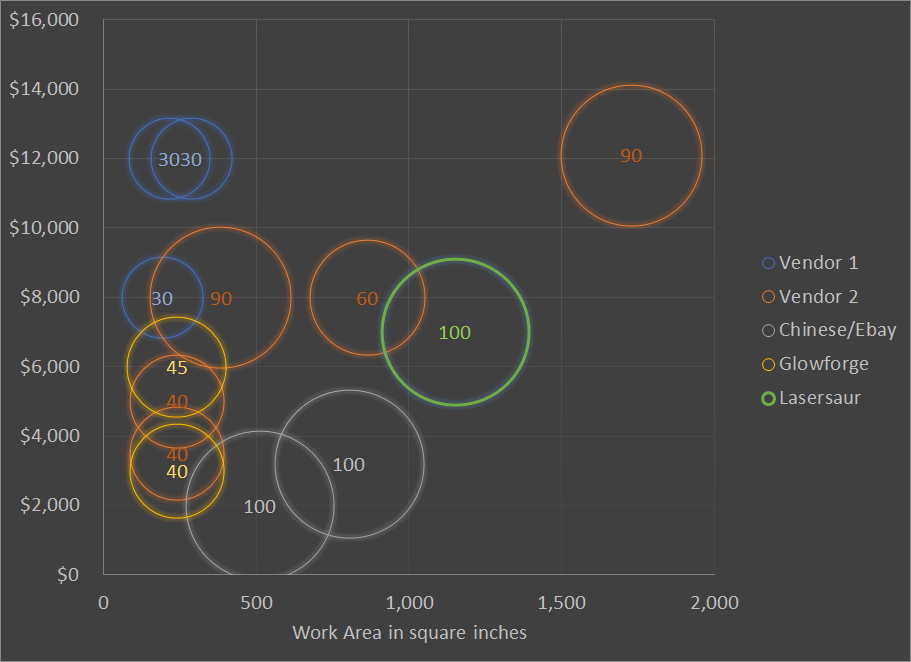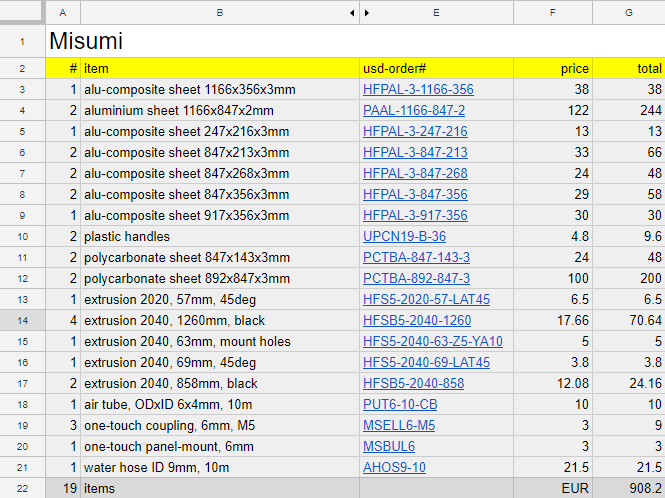One of the hallmarks of the modern maker movement is the progression of an idea in digital form to the manifestation of that idea as a real, physical object. We’re already quite comfortable with the notion of “things” as software, easily shared, modified, and converted to a tangible item on demand. 3D printers and CNC machines are two of the staple devices that power this digital-to-physical workflow. In addition to those, the top wish list tool for many makers is the laser cutter. So let’s build one!
Build, Buy, or Hack?
There are several options for acquiring a laser cutter depending on whether you want to prioritize price, work area size, laser power, features, quality, or other characteristics. This chart compares several options with respect to work area size, price, and laser wattage.
The Lasersaur open source option balances a large work area, high wattage laser, and reasonable cost. It is very much a DIY project, which will be a deal breaker for many, but is a definite plus in this case. Part of the fun is being able to build it from parts (not even a kit), and knowing how everything works will make operation, maintenance, and repairs much easier.
Buying one of the ubiquitous Chinese laser cutters off Ebay would mean a lower up-front cost. But it’s likely that it would require a bunch of work to get to acceptable quality and reliability levels. And unless the electronics are completely swapped out, there’d still be the ugly closed-source tool chain that had to be used.
At the other end of the range are the desktop-sized machines targeted at the hobby market. These tend to have the smallest work areas and laser tubes that would be under-powered for cutting through thicker materials. Options like the Glowforge promise innovative, user-friendly features and professional customer support. Those machines are going to be great for the maker who doesn’t need a beefier setup.
Step 1 : Order (Some) Parts
The Lasersaur Getting Started page says, “The budget you need to allocate if using our suggested suppliers is around USD 7000 for the 100W system (same for EUR as sourcing in Europe is a bit more expensive).” We’re going to try to optimize the costs some, especially since this budget number appears to be somewhat dated, as we’ll see below.
We’re also going to buy parts in stages to spread out the expenses. Steps 1 through 8 (of 14) in the build process cover the construction of the frame and the X and Y axes. That seems like a sensible first chunk to tackle. Here’s how the first parts order came together, following the Bill of Materials provided by Lasersaur.
To get through step 8, 92 of the 111 lines items from Misumi need to be ordered. Here’s what was NOT included with the initial order:
Hopefully when these items are needed, less expensive sources can be identified for the polycarbonate, aluminum, and alu-composite sheets at least. The precision-cut 2020 and 2040 extrusions will still probably have to come from Misumi as specified.
Also ordered were the mechanical parts, the frame panel pack, and the GT timing belt pack from Nortd Labs. The optics, air-assist, and electronics will all be ordered later.
Not yet ordered, but still needed for the first 8 build steps, are the magnetic switches from Mouser and the stepper motors. These items should be easy to get quickly.
How Much Has It Cost So Far?
The total estimated cost in the published BOM is €7,158 or about $8,124. The BOM’s estimated cost and the actual expenses for the items ordered so far are shown here.
This indicates that prices before shipping are tracking very close to the BOM estimates and about 8.5% higher when shipping is included. Extrapolating from this initial order, the projected total cost should be about $8,818. That’s a disappointingly large increase over the “USD 7000” claimed by the Lasersaur website. Perhaps there will be some cost efficiencies with the remaining parts, but it seems more likely that the BOM has been kept up to date but the website hasn’t.
Step 2 : Wait For Parts
The parts from Nortd Labs have shipped, but there’s no ETA on the tracking page yet.
The parts from Misumi are expected to ship on July 10th and should only take a few days to arrive.


